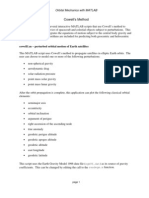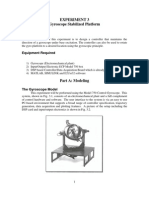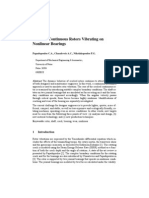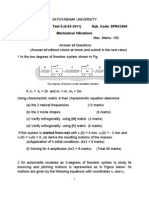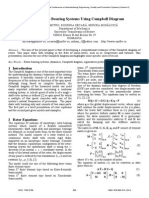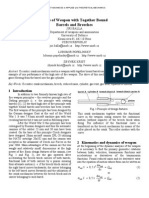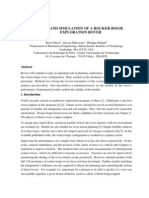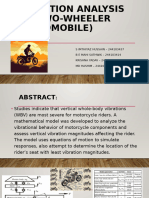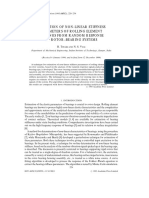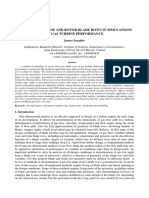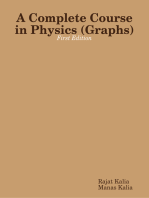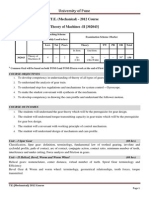Kinematics and Kinetic Analysis of The Slider-Crank Mechanism in Otto Linear Four Cylinder Z24 Engine
Kinematics and Kinetic Analysis of The Slider-Crank Mechanism in Otto Linear Four Cylinder Z24 Engine
Uploaded by
kiran_wakchaureCopyright:
Available Formats
Kinematics and Kinetic Analysis of The Slider-Crank Mechanism in Otto Linear Four Cylinder Z24 Engine
Kinematics and Kinetic Analysis of The Slider-Crank Mechanism in Otto Linear Four Cylinder Z24 Engine
Uploaded by
kiran_wakchaureOriginal Title
Copyright
Available Formats
Share this document
Did you find this document useful?
Is this content inappropriate?
Copyright:
Available Formats
Kinematics and Kinetic Analysis of The Slider-Crank Mechanism in Otto Linear Four Cylinder Z24 Engine
Kinematics and Kinetic Analysis of The Slider-Crank Mechanism in Otto Linear Four Cylinder Z24 Engine
Uploaded by
kiran_wakchaureCopyright:
Available Formats
Journal of Mechanical Engineering Research Vol. 3(3), pp.
85-95, March 2011
Available online at http://www.academicjournals.org/jmer
ISSN 2141 - 2383 2011 Academic Journals
Full Length Research Paper
Kinematics and kinetic analysis of the slider-crank
mechanism in otto linear four cylinder Z24 engine
Mohammad Ranjbarkohan
1
*, Mansour Rasekh
2
, Abdol Hamid Hoseini
3
, Kamran Kheiralipour
4
and Mohammad Reza Asadi
1
1
Department of Mechanical Engineering, Islamic Azad University, Buinzahra branch, Qazwin, Iran.
2
Department of Agricultural Machinery, University of Mohaghegh Ardabili, Ardabil, Iran.
3
Mechanic Engineering in Megamotor Company, Tehran, Iran.
4
Department of Mechanical Engineering of Agricultural Machinery, University of Tehran, Karaj, Iran.
Accepted 26th November, 2010
Nissan Z24 is one of the numerous vehicles in Iran. MegaMotor's reports show high rate damaging in
the crankshaft and connecting rod of this engine vehicle. It is necessary to carry out a complete
research about slider-crank mechanism because of high expensive repairs and replacement of these
parts and their reverse effects on the other parts such as cylinder block and piston. Results of initial
researches show that an important reason of these parts damaging is using of downshifting in driving.
In this research, we are concerned on the analysis of kinematics and kinetic of slider-crank mechanism
of the engine in maximum power, maximum torque and downshifting situation. The influence of
different parameters such as engine RPM and downshifting effects were investigated on crankshaft and
connecting rod loads. Two methods for analyzing of slider-crank mechanism were used: solving
Newton's law and MSC/Adams/Engine software.
Key words: Engine, slider-crank mechanism, kinematics and kinetic, downshifting, Newton's Law, engine rpm.
INTRODUCTION
The base of dynamic mechanism operation of engine is
slider-crank mechanism, which consist of crankshaft,
connecting rod and piston. Combustion pressure
transferred from piston (the part merely has reciprocating
motion) to the connecting rod (the part has both linear
and rotation motion) and finally to the crankshaft (the part
has merely rotation motion).
Cveticanin and Maretic (2000) have studied dynamic
analysis of a cutting mechanism which is a special type of
the crank shaper mechanism (Cveticanin and Maretic,
2000). The influence of the cutting force on the motion of
the mechanism was considered. They used Lagrange
equation to obtain boundary values of the cutting force
analytically and then numerically.
Ha et al. (2006) have derived the dynamic equations of
*Corresponding author. E-mail: ranjbarkohan@gmail.com.
a slider-crank mechanism. They, for this purpose, used
Hamiltons principle, Lagrange multiplier, geometric
constraints and partitioning method (Ha et al., 2006).
Their formulation was expressed by only one
independent variable. Finally to obtain the best dynamic
modeling, they compared obtained results and numerical
simulations.
Also, a new identification method based on the genetic
algorithm was presented to identify the parameters of a
slider-crank mechanism. Koser (2004) investigated on
kinematic performance analysis of a slider-crank
mechanism based on robot arm performance and
dynamics (Koser, 2004). He analyzed kinematic
performance of the robot arm using generalized Jacobian
matrix. It was obtained that the slider-crank mechanism
based robot arm had almost full isotropic kinematic
performance characteristics and its performance was
much better than the best 2R robot arm. He used
complex algebra to solve that classical problem and he
86 J. Mech. Eng. Res.
obtained solution as the root of a cubic equation within a
defined range.
Another research about transmission angle was carried
by Shrinivas and Satish (2002). They have summarized
importance of the transmission angle for most effective
force transmission. In this regard, they investigated 4-, 5-,
6- and 7-bar linkages, spatial linkages and slider-crank
mechanisms.
One of the numerous vehicles in Iran is Nissan Z24,
produced by MegaMotor's company. This company
reports show high rate damaging in the crankshaft and
connecting rod of this engine vehicle. As investigation on
phenomena like vibration, resonance, fatigue, noise . . . ,
and optimization of these parts, kinematics and kinetic of
slider-crank mechanism must be known, it is necessary
to carry out a complete research about slider-crank
mechanism because of high expensive repairs and
replacement of these parts and their reverse effects on
the other parts such as cylinder block and piston. Results
of initial researches show that an important reason of
these parts damaging is using of downshifting in driving.
So, in this research, we concerned on analysis of
kinematics and kinetic of slider-crank mechanism of the
engine in maximum power, maximum torque and
downshifting situation. The influence of different
parameters such as engine rpm and downshifting effects
were investigated on crankshaft and connecting rod
loads.
MATERIALS AND METHODS
At first stage the combustion chamber pressure curve of Nissan
Z24 engine was measured in MegaMotor's power test lab (Engine,
Gearbox and Axel Manufacturing located in Tehran province in Iran,
info@megamotor.ir). These experimental data have been shown in
Figure 1.
Because of different type of motion in this mechanism; such as:
linear, linear-rotation and rotation, there is inertial force in the
system. The inertial force has important role in engine slider-crank
mechanism, so behavior of this force must be known. For analyzing
of inertia force, the kinematics of mechanism should be defined.
Kinematics analysis of slider-crank mechanism
The engine slider-crank mechanism has been shown in Figure 2.
The piston has linear motion in x direction in this figure:
) cos( ) cos( l r x + =
(1)
Where, r is the crank radius, L is the connecting rod length, is the
crank rotation angle and is the connecting rod angle with x axis.
From Figure 1, one can obtain that:
) sin( . ) sin( . l r =
(2)
l
r
n =
(3)
And thus:
) ( sin 1 ) cos(
2 2
n l r x + =
(4)
Using Taylor series in Equation 4:
... ) sin(
16
) sin(
8
) sin(
2
1
1
... )) sin( (
16
1
)) sin( (
8
1
)) sin( . (
2
1
1 )) (sin( 1
6
6
4
4
2 2
6 4 2 2 2
+ + =
+ + =
n n
n
n n n n
(5)
Because n is less than 1(about 0.3), we con eliminate high degree
sentences. Thus:
) 2 cos(
4
1
4
1
1 ) ( sin
2
1
1 ) ( sin 1
2 2 2 2 2 2
n n n n =
(6)
From Equations1 and 6, one can obtain:
)) 2 cos(
4
1
4
1
1 ( ) cos(
2 2
n n l r x + =
(7)
For simplification in calculation we use these notations:
4
4
1
)
4
1 (
4
.
.
2
5
2
4
2
3
2
2
1
n
Q
n
Q
n
l Q
l n
Q
l n Q
=
+ =
=
=
=
(8)
Equation 7 and 8 will result:
3 2 1
) 2 cos( ) cos( Q Q Q x + + =
(9)
Where is the crankshaft rotational velocity. Piston speed obtained
from derivation of Equation (9):
). 2 cos( 2 ). cos(
2 1
Q Q v
P
=
(10)
And for piston acceleration:
) 2 sin( 2 ) 2 cos( 4 ) sin( ) cos(
2
2
2 1
2
1
Q Q Q Q a
P
=
(11)
where is the crankshaft rotational acceleration.
From Equation 11 and Taylor series, for other parts, can reached
the following result:
Ranjbarkohan et al. 87
0
1
2
3
4
5
6
0 100 200 300 400 500 600 700 800
Crank angle (Deg)
P
r
e
s
s
u
r
e
(
M
p
a
)
Combustion pressure on 2800 Rpm(Full load)
Combustion pressure on 2400 Rpm(Full load)
Combustion pressure(Idel)
Figure 1. Combustion pressure in different rpms and loads.
Figure 2. Slider crank mechanism.
( ) ) 2 cos( ) cos(
5 4
Q Q n = (12)
( ) ) sin( ) 2 cos( ) cos(
2
5 4
n Q Q n =
( ) ) 2 sin( ) cos( 2 ) 2 cos(
2
5 5 4
nQ Q Q +
(13)
That is,
is the connecting rod rotational velocity and
is the
connecting rod rotational acceleration.
Now the velocity and acceleration of connecting rods C.G
(Center of gravity) could be calculated. Connecting rod acceleration
could be calculated from Figure 3:
p g p g
a a a
/
r r r
+ = (14)
where
p g
a
/
is acceleration vector of connecting rods C.G relative
the piston, as follow:
) (
/ / / p g p g p g
r r a
r
r r
r r r
+ = (15)
where rg/p is the displacement vector of connecting rods C.G
relative the piston, that (Meriam and Kraige, 1998):
j i s r
p g
) ) sin( ) cos( (
/
= + =
r
j Q e i Q Q e )) sin( ( )) 2 cos( ( (
1 2 3
+ +
(16)
where s is the distance between connecting rods C.G and piston,
and e= s/l . For vertical acceleration of C.G:
Q Q Q a
cx
) 2 cos( 4 ) sin( ) cos( (
2
2 1
2
1
=
Q Q n Q )) 2 cos( ) )( cos( ( ) 2 sin( 2
5 4 2
+
n Q Q n
r
sin( ) cos(
2
1
)) 2 cos( )( sin(
2 3
5 4
2
COS Q Q n eQ )) 2 ( )( ( cos ) sin( )) 2 sin(
2
5 4
2 2 2
1
+
i Q Q e
r
))) 2 cos( (
2 3
+
(17)
88 J. Mech. Eng. Res.
Figure 3. Connecting rod acceleration.
And for horizontal acceleration of C.G:
n Q Q n a
cy
)( sin( )) 2 cos( )( cos( ( (
2
5 4
+ =
n Q Q
r
)) 2 sin( ) cos(
2
1
)) 2 cos( )(
2 3
5 4
n Q Q e )( ( cos )) 2 cos( (
2 2 2
2 3
+
j eQ Q Q
r
)) sin( )) 2 cos( )(
1
2
5 4
(18)
Kinetic analysis of slider-crank mechanism
Kinetic calculation must start from the piston because slider-crank
mechanism started from that. The force diagram of piston was
shown in Figure 4 and Equations 19 and 20:
=
P P x
a m F .
(19)
p p g x
a m F R . =
(20)
The force diagram of connecting rod was shown in Figure 5 and
Equations 21 and 22:
=
=
cx c x x
cx c x
a m R N
a m F .
(21)
cx c p p x x
a m a m R N . . + + =
(22)
Engine torque can be obtained from Figure 6 as follow:
) cos( . . ) sin( . . r N r N T
y x
+ =
(23)
For Ny:
= .
A A
I M
(24)
) 2 cos( .
. ) sin( . .
2 3
Q Q
I r N
N
A x
y
+
=
(25)
Where IA is Inertia of connection rod. But for all journals:
4 3 2 1
T T T T T
C
+ + + =
(26)
That Tc indicates the crankshaft torque, not engine output torque.
Note that the friction force is negligible in comparison with gas
force, so it has ignored in calculations.
Engine output torque from flywheel has been calculated
considering flywheel inertia and resistance torque of crankshaft end
side (Ts). Ts consist of fan, alternator, timing chain and oil pump
resistance torque, as follow:
Alternator Oilpump g Ti fan S
T T T T T + + + =
min
(27)
Ts approximately is 10-15% of total engine output torque.
f f S C f
J T T T . = (28)
For calculation of implied forces over relevant parts like crankshaft
and connecting rod, a FORTRAN program was written used
considering above equations.
Dynamic analysis by Adams/Engine
For checking the accuracy of program, the extract results of
program for sample engine have been compared with results of
Figure 4. Force diagram of piston.
Figure 5. Force diagram of connecting rod.
Figure 6. Force diagram of
crankshaft.
Ranjbarkohan et al. 89
simulating the same engine in Adams/Engine software (Figure 7).
The results of last section and Adams/Engine's output were
compared. The compared results of two methods were shown in
next figure.
Downshifting modeling
As mentioned, the main reason of failing of Nissan engine's
crankshaft is using of downshifting in driving. It means shifting the
gear from light gear (like 3) to heavy gear (like1) and usually is used
for speed control of vehicle by the drivers in very steep roads with
heavy loads. Before shifting from 3 to 1:
3 3 3 3
3
3
3
3
3
.
g g c e
g
c
g
e
g
r r
= = = = (29)
After disengagement of engine and shifting from 3 to 1 and before
releasing the clutch:
(30)
where, rg1 is the first gear ratio, rg3 is the third gear ratio, rd is the
differential ratio, c1 is the clutch plate rotational velocity in gear 1,
c3 is the clutch plate rotational velocity in gear 3, g1 is the
transmission rotational velocity in Gear 1, g3 is the transmission
rotational velocity in Gear 3, e1 is the engine rotational velocity in
Gear 1 and e3 is the engine rotational velocity in Gear 3.
According Equations 29 and 30 and the difference between clutch
and engine rotational speed during releasing the clutch in this
shifting, the torque direction will be diverse from driveline to engine.
Diverse torque will increase the engine speed and then inertia
force, these results will be presented next. By continuing this
reaction between engine and transmission line, in short time
interval, the vehicle will be established in equilibrium condition in
spatial speed. Increment of engine speed has been considered by
two methods:
1. By ignoring the heat dissipation in clutch and using energy
equation:
2
1
2
3
1
2
1
0
.
.
.
.
.
.
|
|
\
|
+
|
|
\
|
|
|
\
|
+
=
g d
w
V e
g
g
g d
w
V e
e S
r r
R
M J
r
r
r r
R
M J
(31)
where, S0 is the engine rotational velocity in engagement starting
90 J. Mech. Eng. Res.
Figure 7. Dynamic model of engine in Adams/Engine
methods.
(energy method), MV is the vehicle mass, Rw is the wheel radius
and Je is the total engine inertia.
2. Numerical solving of engine and transmission system: In this
method, it was supposed one degree of freedom for each set of
engine, such as: clutch, gearbox, differential and vehicle body,
separately. When Engine and clutch are in full engagement:
0 ) ( = + +
s e t e e e e
C C J
& & & &
0 ) (
) ( ) (
1
2 1 2 1 1
= +
+ +
s t
cl cl c
C
C k J
&
& & & &
(32)
When engagement started:
(33)
For other sets before and after engagement:
(34)
where, Jc is the clutch plat inertia, Jg is the gearbox inertia
(equivalent), Jd is the differential inertia (equivalent), Jv is the
vehicle inertia (equivalent), kcl is the clutch spring constant, kp is the
propeller shaft spring (equivalent), kd is the drive shaft spring
(equivalent) and s is the steady rotational speed in engagement
(rpm).
An example of downshifting and way of increasing the engine
velocity were shown in Figure 8. This figure shows quick increase in
engine velocity and applying torque to engine with maximum
capacity of clutch.
RESULTS
Comparison between methods of solution
In Figures 9, 10 and 11, crankshaft output torque and pin
journal vertical force for 2800 and 4800 rpm in both
Adams/Engine and Newton's Law Results method were
compared. As seen in these figures, results of two
methods show that each method verifies other one.
Kinematics
The piston and connecting rod acceleration are main
results of kinematics analysis of the mechanism. In
Figures 12, 13 and 14 acceleration of piston and
connecting rod in 2800, 4800, 5700 and 6500 rpm were
shown. As seen in these figures, all accelerations
increased with increasing of engine velocity. The
connecting rod horizontal acceleration is very important
because of its major role on the torque.
In Figures 12 and 13, there is an observation that
connecting rod vertical acceleration is nearly similar to
piston acceleration. This is due to low horizontal
displacement of that.
Kinetic
In Figures 15 and 16, the crankpin force (horizontal and
vertical), crankshaft torque and flywheel torque were
shown in maximum torque and maximum power,
respectively. From these figures, one can get the
following:
1. Flywheel and clutch design: By average value and
fluctuation ratio (flywheel design parameter) could design
the suitable flywheel. Majority of this fluctuation is
absorbed by flywheel. The clutch could be design after
flywheel designation and consideration of output torque
etc.
2. Resonance phenomena: Resonance phenomena are a
main factor of damaging. The applying of torque to the
crankshaft is motivational factor to engine and even
transmission system (after the fluctuation absorbed by
flywheel). By using frequency and amplitude of fluctuation
and natural frequency of parts such as cylinder block and
crankshaft (with flywheel), the design can be optimized
for prevention from resonance.
3. Stress analysis: As the engine is damaged, stress
analysis of different situation for some parts is essential.
The fatigue analysis of moving part such as connecting
rod and crankshaft could be done by using the diagrams.
Downshifting
In downshifting, as the combustion pressure is very low,
Ranjbarkohan et al. 91
Figure 8. Downshift gear from 3 to 1.
Figure 9. Comparison of crankshaft output torque between Adams/Engine and
Newtons law results.
-10000
-5000
0
5000
10000
15000
20000
25000
30000
0 100 200 300 400 500 600 700 800
Crank angle(Deg)
Adams/Engine results solving newtonian relations result? s
F
o
r
c
e
(
N
)
Figure 10. Comparison of pin journal vertical force between Adams/ Engine
and Newtons law results (2800 rpm).
92 J. Mech. Eng. Res.
-20000
-15000
-10000
-5000
0
5000
10000
15000
20000
0 100 200 300 400 500 600 700 800
Crank angl e(Deg)
Adams/ Engine resul ts solving newt onian rel ations results?
F
o
r
c
e
(
N
)
Figure 11. Comparison of pin journal vertical force between Adams/ Engine and
Newtons law results (4800 rpm).
Figure 12. Piston acceleration in different rpms.
Figure 13. Connecting rod vertical acceleration in different rpms.
Ranjbarkohan et al. 93
Figure 14. Connecting rod horizontal acceleration in different rpms.
-10000
-5000
0
5000
10000
15000
20000
25000
30000
0 100 200 300 400 500 600 700 800
Crank angle (Deg)
-100
0
100
200
300
400
500
600
crankpin horizontal force crankpin vertical force crankshaft torque flywheel torque
T
o
r
q
u
e
(
N
.
M
)
F
o
r
c
e
(
N
)
Crankpin horizontal force Crankpin vertical force Crankshaft torque Flywheel torque crankpin horizontal force crankpin vertical force
Figure 15. The horizontal and vertical crankpin force, crankshaft and flywheel torque
in maximum torque.
-20000
-15000
-10000
-5000
0
5000
10000
15000
20000
0 100 200 300 400 500 600 700 800
Crank angle (Deg)
-400
-200
0
200
400
600
800
1000
crankpin horizontal force crankpin vertical force crankshaft torque flywheel torque
F
o
r
c
e
(
N
)
T
o
r
q
u
e
(
N
.
M
)
Crankpin horizontal force Crankpin vertical force Crankshaft torque Flywheel torque crankpin horizontal force crankpin vertical force
Figure 16. The horizontal and vertical crankpin force and crankshaft and flywheel torque in
maximum power.
94 J. Mech. Eng. Res.
-40000
-30000
-20000
-10000
0
10000
20000
30000
0 100 200 300 400 500 600 700 800
Crank angle (Deg)
2800 Rpm 4800 Rpm 5700 Rpm 6500 Rpm
F
o
r
c
e
(
N
)
Figure 17. Crankpin vertical force in different rpms (down shift gear situation).
-15000
-10000
-5000
0
5000
10000
15000
0 100 200 300 400 500 600 700 800
Crank angle (Deg)
2800 Rpm 4800 RPM 5700 Rpm 6500 Rpm
F
o
r
c
e
(
N
)
Figure 18. Crankshaft pin journal horizontal force in different rpms (down shift gear
situation).
the inertia forces are important. In Figures 17, 18 and 19
vertical and horizontal force of crankpin and crankshaft
torque in different velocities was shown.
From the figures, it could be understood that the inertia
forces are quick increased unsteadily with velocity
increasing. The forces and torques are sinusoidal with
average value near to zero. Another result of velocity
increasing is applying high load to all journals. This is
clearer in the downshifting situation.
From comparison of downshifting situation and full load
we could conclude that the applied load in the
downshifting is greater than full load and has high
frequency because the velocity is high. Thus the
possibility of fatigue occurring in this situation is very
high.
Conclusion
In this research, the followings were concluded:
1. There is a well agreement between Newton's law
results and Adams/Engine methods.
2. High load is applied to engine in downshifting in
comparison with full load condition. There is a necessity
for stress, fatigue and frailer in these conditions.
3. Training drivers not to use downshifting and out of
standard load on vehicle.
4. Defining maximum speed of engine in electronic
control unit (ECU) for preventing uncontrollable loading
on engine and downshift situation.
5. Referring to issued statistics from Megamotors
Ranjbarkohan et al. 95
-2000
-1500
-1000
-500
0
500
1000
1500
2000
0 100 200 300 400 500 600 700 800
Crank angle (Deg)
2800 Rpm 4800 Rpm 5700 Rpm 6500 Rpm
T
o
r
q
u
e
(
N
.
M
)
Figure 19. Crankshaft output torque in different s (down shift gear situation).
Company and analysis results, the main reason of parts
failure is abnormal using of vehicle by drivers.
Terminology: a
cx
, Vertical acceleration; a
cy
, horizontal
acceleration; A
g
, connecting rod acceleration; a
g/p
,
acceleration vector of connecting rods C.G relative
piston; a
p
, piston acceleration; C.G, center of gravity; F
x
,
force in X direction; I
A
, inertia of connection rod; J
e,
Total
engine inertia; J
c,
clutch plat inertia; J
g,
gearbox inertia;
J
d,
differential inertia; J
v,
vehicle inertia; k
cl,
clutch spring
constant; k
d,
drive shaft spring; k
p,
propeller shaft spring;
L, connecting rod length; M
V
, vehicle mass; m
p
, piston
mass; N
x
, resistance of pin end in X direction; N
y
,
resistance of pin end in Y direction;
R
w
,
wheel radius;
R
w
,
wheel radius;
R
x
,
resistance of crank end in X direction;
R
y
,
resistance of crank end in Y direction; r, crank radius;
r
g
1, first gear ratio; r
g3,
Third gear ratio; r
d,
differential
ratio; r
g/p,
displacement vector of connecting rods C.G
relative piston; s, distance between connecting rods C.G
and piston; T
c
, crankshaft torque; T
f
, flywheel torque; T
s
,
resistance torque of crankshaft end side; v
p
, piston
speed; ,
crankshaft rotational acceleration; ,
connecting rod angle;
, connecting rod rotational
velocity;
,
connecting rod rotational acceleration;
, crank rotation angle; , crankshaft rotational velocity;
e1
, engine rotational velocity in gear 1;
e3
, engine
rotational velocity in gear 3;
c1
, clutch plate rotational
velocity in gear 1;
c3
, clutch plate rotational velocity in
gear 3;
g1
, transmission rotational velocity in gear 1;
g3
, Transmission rotational velocity in gear 3;
s
, steady
rotational speed in engagement;
S0
, engine rotational
velocity in engagement starting.
REFERENCES
Cveticanin L, Maretic R (2000). Dynamic analysis of a cuttin
mechanism. Mech. Mach. Theory, 35(10): 1391-1411.
Ha JL, Fung RF, Chen KY, Hsien SC (2006). Dynamic modeling and
identification of a slider-crank mechanism. J. Sound Vib., 289(4):
1019-1044.
Koser K (2004). A slider-crank mechanism based robot arm
performance and dynamic analysis. Mech. Mach. Theory, 39(2): 169-
182.
Meriam JL, Kraige LG (1998). Engineering Mechanics, 5th Edition, New
York, john willey, p. 712.
Shrinivas SB, Satish C (2002). Transmission angle in mechanisms
(Triangle in mech). Mech.Mach. Theory, 37(2): 175-195.
You might also like
- Cowell's Method: Cowell1.m - Perturbed Orbital Motion of Earth SatellitesDocument25 pagesCowell's Method: Cowell1.m - Perturbed Orbital Motion of Earth Satellitesbaixiu0813No ratings yet
- Mechanics of Machines (314205) : Design, Fabrication and Analysis of Dual Can CrusherDocument10 pagesMechanics of Machines (314205) : Design, Fabrication and Analysis of Dual Can Crushersaqlain05No ratings yet
- Admin,+Journal+Manager,+42 25.docxenglishDocument18 pagesAdmin,+Journal+Manager,+42 25.docxenglishJose BarreraNo ratings yet
- Non-Circular Gear Wheels in The Geared-Linkages Mechanisms: Abstract-In This Paper A Method To Compute TheDocument6 pagesNon-Circular Gear Wheels in The Geared-Linkages Mechanisms: Abstract-In This Paper A Method To Compute TheMohamed KhairyNo ratings yet
- Dynamic Analysis of Crank-Connecting Rod-Piston Mechanism of S195 Diesel Engine Based On MATLABDocument5 pagesDynamic Analysis of Crank-Connecting Rod-Piston Mechanism of S195 Diesel Engine Based On MATLAByangee1201No ratings yet
- Sustainability 10 02067 PDFDocument19 pagesSustainability 10 02067 PDFDeenanathNo ratings yet
- Heat Dynemic Gear Transmıssıon SystemDocument18 pagesHeat Dynemic Gear Transmıssıon SystemkarayagizmuhammedNo ratings yet
- Automobile Vibration AnalysisDocument18 pagesAutomobile Vibration AnalysisDavid PomaNo ratings yet
- Lab 3 - Gyroscope Stabilized PlatformDocument13 pagesLab 3 - Gyroscope Stabilized PlatformFabian ZenderNo ratings yet
- Cracked Continuous Rotors Vibrating On Nonlinear BearingsDocument10 pagesCracked Continuous Rotors Vibrating On Nonlinear BearingslucastcNo ratings yet
- Research On Kinematics of 3-Dof Connecting Rod ManDocument10 pagesResearch On Kinematics of 3-Dof Connecting Rod Manpad abtNo ratings yet
- Can Crusher MechanismDocument23 pagesCan Crusher Mechanismsaqlain05No ratings yet
- Crankshaft VibrationDocument8 pagesCrankshaft VibrationjohansolNo ratings yet
- Vib QN Paper Test IIDocument4 pagesVib QN Paper Test IIRaghupathi ManickamNo ratings yet
- Study of Rotor-Bearing Systems Using Campbell DiagramDocument4 pagesStudy of Rotor-Bearing Systems Using Campbell DiagrammishraenggNo ratings yet
- Unit 4 Flywheel: StructureDocument21 pagesUnit 4 Flywheel: StructureShivam Gupta0% (2)
- 56 421Document10 pages56 421nguyendattdhNo ratings yet
- Single Axis Text I J Mic 08075 FinalDocument26 pagesSingle Axis Text I J Mic 08075 Finalali almorsedNo ratings yet
- Paper - On The Dynamic Analysis of Rotor-Bearing SystemsDocument8 pagesPaper - On The Dynamic Analysis of Rotor-Bearing SystemsVILLANUEVA_DANIEL2064No ratings yet
- Stress Analysis and Weight Reduction of A One-CyliDocument18 pagesStress Analysis and Weight Reduction of A One-CyliAnonymous K3FaYFlNo ratings yet
- Dynamic Modelling (Intech)Document304 pagesDynamic Modelling (Intech)leonardo_arévalo_28No ratings yet
- Example PDFDocument5 pagesExample PDFhugur soNo ratings yet
- An Experimental Study Evaluating ParametDocument12 pagesAn Experimental Study Evaluating ParametJonas Cândido Da SilvaNo ratings yet
- Road Friction Coefficient PredictionDocument13 pagesRoad Friction Coefficient PredictionleullNo ratings yet
- Optimal Synthesis of A Single-Dwell 6-Bar Planar LinkageDocument7 pagesOptimal Synthesis of A Single-Dwell 6-Bar Planar LinkageInternational Journal of computational Engineering research (IJCER)No ratings yet
- Drive of Weapon With Together Bound Barrels and BreechesDocument6 pagesDrive of Weapon With Together Bound Barrels and Breechesihv69No ratings yet
- Kinematic of Marine Piston-Crankshaft System: Lech MurawskiDocument8 pagesKinematic of Marine Piston-Crankshaft System: Lech MurawskiCojocaru TiberiuNo ratings yet
- Kom 2Document3 pagesKom 2vikas2504No ratings yet
- EK407 BEK4013 - TEST 2 - Solution Jan2023Document6 pagesEK407 BEK4013 - TEST 2 - Solution Jan2023mahrusNo ratings yet
- Modeling Induction Motors: Abstract: in This Paper, A Novel Technique For On-Line Estimation of MostDocument10 pagesModeling Induction Motors: Abstract: in This Paper, A Novel Technique For On-Line Estimation of Mostseshubabu_999No ratings yet
- Theory of MachinesDocument50 pagesTheory of MachinesHari Prasad100% (1)
- THRD PD 29febDocument7 pagesTHRD PD 29febvijay_marathe01No ratings yet
- Paper Suspension Rocker BogieDocument8 pagesPaper Suspension Rocker BogieJorge EstradaNo ratings yet
- Vibration Analysis of Two Wheeler (Automobile - SYED IMTHIYAZ HUSSAIDocument22 pagesVibration Analysis of Two Wheeler (Automobile - SYED IMTHIYAZ HUSSAIAonish kumarNo ratings yet
- Structural Dynamic Analysis of Cyclic Symmetric Structures: Senior Systems Engineer, SAIC, Huntsville, AL 35806Document26 pagesStructural Dynamic Analysis of Cyclic Symmetric Structures: Senior Systems Engineer, SAIC, Huntsville, AL 35806Silvia BertiNo ratings yet
- Vibration and Kinematic Analysis of Scara Robot Structure: Diyala Journal of Engineering SciencesDocument17 pagesVibration and Kinematic Analysis of Scara Robot Structure: Diyala Journal of Engineering SciencesmouaadhNo ratings yet
- Kinematics, Dynamics and Mechanical Efficiency of A Cardan Joint With Manufacturing Tolerances - Part IiDocument6 pagesKinematics, Dynamics and Mechanical Efficiency of A Cardan Joint With Manufacturing Tolerances - Part IiDenis MataNo ratings yet
- Tiwari - Non Linear Stiffness Bearing ParametersDocument11 pagesTiwari - Non Linear Stiffness Bearing Parameterssimone.castagnettiNo ratings yet
- Theoretical and Experimental Efficiency Analysis of Multi-Degrees-of-Freedom Epicyclic Gear TrainsDocument21 pagesTheoretical and Experimental Efficiency Analysis of Multi-Degrees-of-Freedom Epicyclic Gear TrainsAmin ShafanezhadNo ratings yet
- Robust H Controller For Construction Elevator Drivesystem Vibrations AttenuatorDocument9 pagesRobust H Controller For Construction Elevator Drivesystem Vibrations AttenuatorDr Saba TareqNo ratings yet
- 3 Story Seismic AnalysisDocument15 pages3 Story Seismic AnalysisKavita Kaur KamthekarNo ratings yet
- 1 Flexible Link ProjectDocument15 pages1 Flexible Link Projectprasaad08No ratings yet
- Fullp-J - Sznajder - Blade-Rows KONES - 2019Document8 pagesFullp-J - Sznajder - Blade-Rows KONES - 2019Janusz SznajderNo ratings yet
- Tamboli 1999Document13 pagesTamboli 1999Charly MercadoNo ratings yet
- Theory of AutomotiveDocument9 pagesTheory of AutomotivePhuc NguyenNo ratings yet
- Igcse Sample PaperDocument8 pagesIgcse Sample PaperharshanauocNo ratings yet
- Cam Experimental Lab: ObjectiveDocument8 pagesCam Experimental Lab: ObjectiveMuhammad Changez Khan100% (2)
- 11 - Introduction To MechanismsDocument45 pages11 - Introduction To MechanismsHoozefa J. ShaikhNo ratings yet
- The Evaluation of Rotor Imbalance in Flexibly Mounted MachinesDocument13 pagesThe Evaluation of Rotor Imbalance in Flexibly Mounted MachinesCésar TapiaNo ratings yet
- Mechanism and Machine Theory: Roland Mathis, Yves RemondDocument13 pagesMechanism and Machine Theory: Roland Mathis, Yves RemondStefan IlicNo ratings yet
- Two Speed Epicycle Gear TrainsDocument7 pagesTwo Speed Epicycle Gear Trainsxmtqnkn8vjNo ratings yet
- IMAC XV 15th Int 15-49-3 Optimization Techniques RotordynamicsDocument7 pagesIMAC XV 15th Int 15-49-3 Optimization Techniques Rotordynamicsuamiranda3518No ratings yet
- Dynamic Response of 2 Dof Quarter Car Passive Suspension System (QC-PSS) and 2 Dof Quarter Car Electrohydraulic Active Suspension System (QC-EH-ASS)Document21 pagesDynamic Response of 2 Dof Quarter Car Passive Suspension System (QC-PSS) and 2 Dof Quarter Car Electrohydraulic Active Suspension System (QC-EH-ASS)LISHANTH BNo ratings yet
- Design of Variable Coupler Curve Four-Bar Mechanisms: Ren-Chung Soong and Sun-Li WuDocument9 pagesDesign of Variable Coupler Curve Four-Bar Mechanisms: Ren-Chung Soong and Sun-Li WuAshokNo ratings yet
- Mengsiliu 2010Document8 pagesMengsiliu 2010Jose BarreraNo ratings yet
- V6 90 Engine Vibration Analysis and Discussion 1706352546Document13 pagesV6 90 Engine Vibration Analysis and Discussion 1706352546Francesco MasillaNo ratings yet
- Inverse Kinematics Problem (Ikp) of 6-Dof Manipulator by Locally Recurrent Neural Networks (LRNNS)Document5 pagesInverse Kinematics Problem (Ikp) of 6-Dof Manipulator by Locally Recurrent Neural Networks (LRNNS)yousif al mashhadanyNo ratings yet
- Kinematics and Dynamics Analysis of The Main MotioDocument9 pagesKinematics and Dynamics Analysis of The Main MotiosbkjasbfaskjfbjkNo ratings yet
- Robot Manipulators: Modeling, Performance Analysis and ControlFrom EverandRobot Manipulators: Modeling, Performance Analysis and ControlNo ratings yet
- Tom-I Question Bank UpdatedDocument174 pagesTom-I Question Bank Updatedkiran_wakchaureNo ratings yet
- Iction Stir WeldingDocument16 pagesIction Stir Weldingkiran_wakchaureNo ratings yet
- Simulation of Slider Crank Mechanism Using Adams ViesDocument5 pagesSimulation of Slider Crank Mechanism Using Adams Vieskiran_wakchaureNo ratings yet
- CFD Course: Sanjivani College of Engineering, KoparagaonDocument2 pagesCFD Course: Sanjivani College of Engineering, Koparagaonkiran_wakchaureNo ratings yet
- IRJET Manuscript TemplateDocument3 pagesIRJET Manuscript Templatekiran_wakchaureNo ratings yet
- Introduction To Kinematics of MachinesDocument16 pagesIntroduction To Kinematics of MachinesHarsha PrasadNo ratings yet
- Fuzzy Logic and It's ApplicationsDocument21 pagesFuzzy Logic and It's Applicationskiran_wakchaureNo ratings yet
- Mechanical Stepless DrivesDocument7 pagesMechanical Stepless Driveskiran_wakchaure50% (2)
- Prepared By: Prof K N Wakchaure: A Frame Which Supports The Cam and Guides The FollowerDocument11 pagesPrepared By: Prof K N Wakchaure: A Frame Which Supports The Cam and Guides The Followerkiran_wakchaureNo ratings yet
- Fea Tips Tricks Post ProcessinDocument12 pagesFea Tips Tricks Post Processinkiran_wakchaureNo ratings yet
- 03 Te Tom-IiDocument3 pages03 Te Tom-Iikiran_wakchaureNo ratings yet
- 2D & 3D TrussDocument43 pages2D & 3D Trusskiran_wakchaureNo ratings yet
- Ansys Commands and AcronymsDocument3 pagesAnsys Commands and Acronymskiran_wakchaureNo ratings yet
- Young's Modulus (Modulus of Elasticity) - E - Ultimate Tensile Strength - S Yield Strength - SDocument6 pagesYoung's Modulus (Modulus of Elasticity) - E - Ultimate Tensile Strength - S Yield Strength - Skiran_wakchaureNo ratings yet
- Government Schemes: Jaggery Powder Plant ManufacturerDocument6 pagesGovernment Schemes: Jaggery Powder Plant Manufacturerkiran_wakchaureNo ratings yet
- 16 Jaggery From SugarcaneDocument8 pages16 Jaggery From Sugarcanekiran_wakchaureNo ratings yet
- Metal Casting Process - 3Document11 pagesMetal Casting Process - 3kiran_wakchaureNo ratings yet
